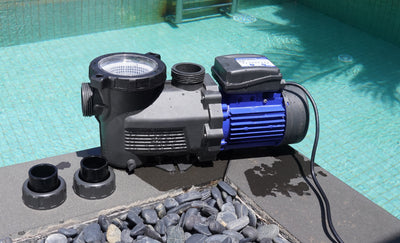Baquacil Pool Chemistry 101: The Complete Guide for AQUASTRONG Pool Care
When it comes to keeping your pool clean and sanitized, chlorine is likely the first sanitizer that comes to mind. However, if you're looking for an alternative to chlorine, especially one that’s gentler on your skin, eyes, and hair, Baquacil may be the solution you're seeking. As an effective chlorine-free sanitizer, Baquacil can help you maintain crystal-clear water without the harsh effects associated with chlorine. In this guide, we’ll take a closer look at what Baquacil is, how it works, its benefits, and the best practices for pool care with AQUASTRONG products.
What is Baquacil?
Baquacil is a chlorine-free pool sanitizer based on polyhexamethylene biguanide (PHMB), commonly referred to as biguanide. Initially developed as a surgical disinfectant, this compound has proven effective in controlling bacteria and algae in swimming pools. As opposed to chlorine-based sanitizers, which can have harsh side effects on the skin and respiratory system, Baquacil offers a gentler alternative for those sensitive to chlorine.
Baquacil is most often used alongside other pool care products, such as oxidizers and algaecides, which are specially formulated to complement this sanitizer. AQUASTRONG carries a range of pool chemicals and equipment to help you maintain your pool in top condition, including compatible products designed for use with Baquacil.
How Does Baquacil Work?
The primary ingredient in Baquacil, biguanide, works by binding contaminants in the water into larger clumps, which are then filtered out by your pool’s filtration system. This process helps maintain clean, clear water, but it does mean your filter may clog more frequently than when using chlorine-based sanitizers. Therefore, it’s important to clean your filter regularly to keep everything running smoothly.
Benefits of Baquacil
-
Gentler on Skin and Eyes
If you or your family members have experienced skin rashes, irritated eyes, or dry hair from chlorine exposure, Baquacil offers a kinder alternative. It’s less likely to cause irritation, making it a popular choice for individuals with sensitive skin. -
No Chloramine Formation
Unlike chlorine, Baquacil doesn’t produce chloramines, which are the compounds responsible for the familiar pool smell and can irritate the eyes and respiratory system. Without chloramines, your pool water will smell fresh, and you won’t have to worry about respiratory discomfort. -
More Stable in Sunlight
Chlorine breaks down under the sun’s ultraviolet (UV) rays, requiring frequent maintenance. Baquacil, on the other hand, is more stable and won’t degrade as quickly, which means fewer adjustments to sanitizer levels over time. -
Prevents Green Hair
Swimming in a chlorine-treated pool can cause blonde or light-colored hair to turn green due to the oxidation of copper. Baquacil doesn’t oxidize metals, so you can enjoy your swim without worrying about discoloration.
Drawbacks of Baquacil
While Baquacil has many advantages, there are some factors to consider:
-
Higher Cost
Baquacil and its related products are generally more expensive than chlorine-based alternatives. In addition to the sanitizer, you’ll need to purchase oxidizers and algaecides specifically formulated for use with biguanide sanitizers. The increased cost should be weighed against the benefits of a gentler, chlorine-free pool experience. -
Requires Additional Products
Baquacil doesn’t oxidize organic contaminants like chlorine does, meaning you’ll need to use additional oxidizer products to break down substances like body oils, sweat, and sunscreen. It’s also important to use algaecides that are compatible with Baquacil, which can further increase pool maintenance costs. -
Possible Cloudiness
While Baquacil effectively sanitizes your pool, the process of binding contaminants together can sometimes cause the water to appear cloudy. Regular filter maintenance and the use of flocculants can help clear up any haze.
Key Chemical Levels for Baquacil Pool Care
To ensure your Baquacil-treated pool remains in optimal condition, it’s essential to maintain specific chemical levels.
-
Baquacil Sanitizer
Keep your Baquacil sanitizer levels between 40–50 parts per million (ppm), ensuring it never drops below 30 ppm. This will maintain a safe and clean swimming environment. -
pH Levels
Baquacil can influence your pool's pH, so it's essential to regularly test and adjust the pH level. The ideal pH range for a Baquacil pool is between 7.4 and 7.6. -
Alkalinity
The optimal alkalinity level for a pool using Baquacil is between 100 ppm and 150 ppm. Maintaining proper alkalinity ensures your pool’s pH remains stable and prevents rapid fluctuations that could disrupt the chemical balance. -
Calcium Hardness
Calcium hardness should be kept between 175 ppm and 275 ppm to prevent cloudiness and scale buildup. If levels fall outside this range, you may need to add calcium hardness increaser or adjust the water to ensure proper balance. -
Oxidizer and Algaecide
Baquacil requires an oxidizer to remove organic contaminants like oils and body waste. Additionally, using a Baquacil-compatible algaecide helps prevent algae growth, ensuring your pool stays clear and clean.
How to Convert from Chlorine to Baquacil
If you’re ready to make the switch from chlorine to Baquacil, spring is the best time to do so. Here’s a general overview of the process:
-
Clean Your Pool Filter
Begin by thoroughly cleaning your pool filter to remove any chlorine residue. If your filter is old or heavily contaminated, consider replacing it for the best results. -
Test Your Pool Water
Have your pool water tested by a professional to check for metals. If metals are present, use a metal control product to remove them before proceeding. -
Add Baquacil Sanitizer
Once your pool is prepared, add the necessary amount of Baquacil Sanitizer to achieve the desired 50 ppm concentration. Continue testing until the right level is reached. -
Add Oxidizer and Algaecide
After adding the sanitizer, you’ll need to introduce the Baquacil Oxidizer and compatible algaecide to ensure thorough sanitation and prevent algae growth. -
Routine Maintenance
Once your pool is properly balanced, regular maintenance is essential. Keep an eye on sanitizer levels, pH, alkalinity, and calcium hardness to ensure a sparkling pool all season long.

